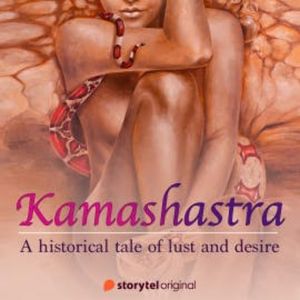The Kamasutra - India's famous love manual has been dated to somewhere between the 3rd and 6th Century CE. But it's author, Sage Vatsyayana, was only the compiler of the sutra. Lost in the annals of history is his inspiration, the first study of erotic experiences conducted by a royal scribe of the Satvahana Dynasty that ruled the western part of present day India in the 1st and 2nd Century CE.
King Astra - a big bear of a man who ruled over Nasikatrhi had 3 wives and a palace of 72 concubines. Things came to a head when he married for the fourth time - an incandescent beauty, the royal princess Veda who was nubile, goddess-like and more desirable than any woman in the kingdom. Unable to satisfy her and overcome with the desire to do so, Astra ordered his royal scribe, the young and handsome Dhruv to write a book guiding the king on sexual congress to please his new bride - the Kamashastra. To do this, the scribe was given a free rein over the king's palace of concubines.
Thus began Dhruv's quest which led him to various beds - from different women, the young and virile scribe learnt different techniques - literally going where no man had been before. So absorbed was he in his thirst, that he soon caught the eye of the queens - including the unattainable, the unreachable Queen Veda. Entangled in the jealous web of the other queens, court politics, the rising Bhraman disapproval as well the King's impending wrath, Dhruv wrote a masterpiece which revealed the conjugal secrets of bliss and climax - what women did in the sanctuary of their inner chambers, the different types of women basis their sexuality, the elevated pleasures of enjoying sex with more than one partner, the excitement caused by the danger of exhibitionism, voyeurism, skilled and pleasurable bondage and games played beneath the surface. The liberation, salvation and damnation of sex and lust. This is the story of the discovery of sexual release. This is the Kamashastra.
This is a work of fiction. Unless otherwise indicated, all the names, characters, businesses, places, events and incidents in this book are either the product of the author's imagination or used in a fictitious manner. Any resemblance to actual persons, living or dead, or actual events is purely coincidental.
Kamashastra
- Sprecher
- Dauer
- 2 Stunden 9 Minuten
- Verlag
- Typ
- Ungekürzt
- Format
- Hörbuch Download
- ISBN
- 9789353982195
- Sprache
- Englisch
- Kategorie
Vollversion anhören
2,99 €
Beschreibung
Bewertungen und Rezensionen
Nur angemeldete Nutzer können Bewertungen abgeben. Jetzt anmelden
Die Meinungen stammen von angemeldeten Kunden, die unser Produkt oder unsere Dienstleistung gekauft haben. Die Meinungen werden in Übereinstimmung mit den Bewertungsrichtlinien gesammelt, überprüft und veröffentlicht.
Vollversion anhören
2,99 €
